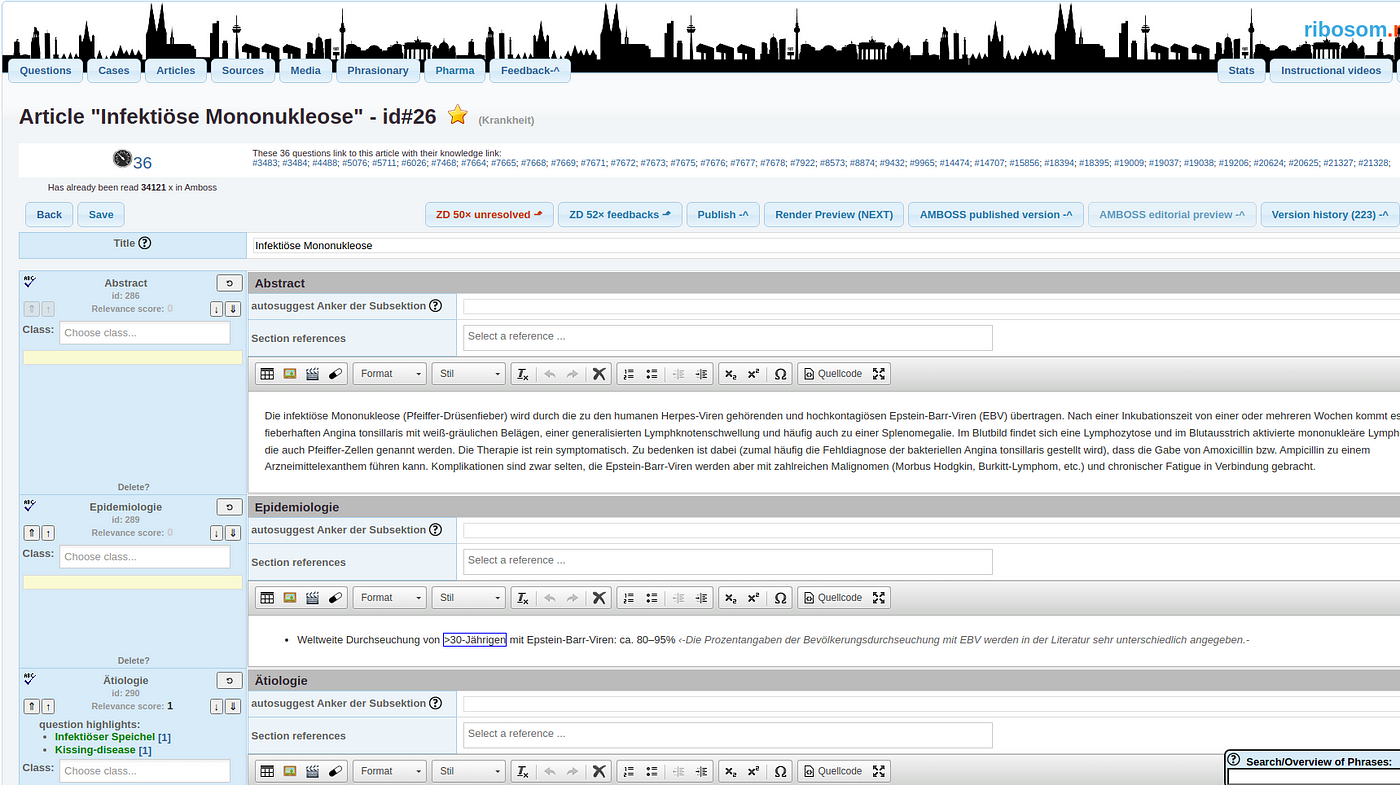A content management system grows up
From a naturally grown hodgepodge, to a high-performance content innovation platform

Amboss 2014 — a group of medical experts and software developers puts their heads together: someone had a new idea. Who exactly? Nobody remembers. After hours of brainstorming, hacking, and testing: new questions for students are online, Amboss is better than before. Success!!
Amboss 2022 — the backlog of exciting topics is long. The team that among other things implements changes into the content management system (CMS) collects them whenever medical experts or a product team throws them over the fence. Prioritization? A tough job.
What happened?
In a startup environment, understanding the product and how to develop it, is shared among all contributors. People in different roles talk to each other almost daily. Complexity is low. Everyone is part of something bigger — the real startup vibe.
With success comes growth. With growth comes detachment. Structures get introduced, roles and departments established. The business flourishes.
AMBOSS has written such a success story. Having saturated the German medical student market, the US medical student market was next. Students turn into physicians. AMBOSS is still there with them. And faster than your mind can follow, AMBOSS has served multiple markets with multiple users’ needs, established specialized teams, and matured in many other ways.
Speed and adaptability as the key to success
Backstage, the one piece of tech that keeps it all together is the content management system (CMS). Content is one of the main value propositions of many products developed for experts in their fields, and needs special care and attention.
Now, a CMS is a wild animal! For knowledge at this level, there is no ‘one-size fits it all’.
AMBOSS developers realized this early on, so they built the AMBOSS CMS Ribosom right from the start. Because the company’s initial focus was on exams, the creation of question-answer pairs on the CMS was supported. Students use this question bank to prepare for their exams, and AMBOSS medical experts augment these questions with explanations and tips that make it easier to understand the context.
The CMS also had to accommodate articles to enrich the question bank with essential reading matter and images. To make use of the digital nature of this innovative textbook, linked layers of information to “jump your way through medicine” were developed.
Physician users, however, need different content —more practical, calculators, drug information. A colorful bouquet of content-type flowers blossomed for different markets, and with it, the system to manage this variety.
First, it grew into a tree, and then into a forest. This forest has some massive and well used main roads, but it also has tangled undergrowth where only the most courageous dare to venture. Travelers as well as the foresters avoid some of the paths, and new roads are hard to clear because the branches are too thick, the machetes too dull.
Approaching decision time
Working with a CMS such as Ribosom creates a variety of challenges.
First, there’s a limited number of people who have all of the relevant knowledge to introduce changes to it — let’s call it the knowledge bottleneck. It exists on two levels.
On one level, legacy code requires a certain degree of knowledge about the past. Why was this fix introduced here? What happens if I remove this bit of business logic? How do I introduce a fix for a problem without causing another?
On another level, changes require the knowledge of the programming language and libraries that are used. This makes it hard for developers from teams that focus on product areas using other technology to contribute.
As a result, this one system serves the content for all product teams. This means that the needs and solutions for content creation are discussed in a team that’s separate from product development teams.
This can result in a misalignment of priorities and interpretation of needs between content creation backend, and content consumer teams that eventually build the product for the users.
The second challenge lies in its extensibility. As long as products are based on fairly similar types and structures of content, they can be served with similar content management technology. The more innovative a product idea is though, the harder it is to use the existing content and technology. In the worst case, this leads to an innovation lock, which can endanger the long-term success of a company.
The last issue to mention is usability. Organically grown as it is, Ribosom serves many use cases and enables our medical editors to deliver content. The fast growth comes with a price — solutions were optimized to the existing code, rather than for editorial efficiency.

Laying down the tracks for sustainable growth
All of the above-mentioned challenges aren’t a mistake someone made, but rather remnants left behind on the path to success. You have to break an egg to make an omelet. The ability to react fast, spend resources smartly, and use synergies set AMBOSS apart from the crowd over the last couple of years.
AMBOSS is now entering a maturity phase where it’s vital to revisit foundations, rebuilding them stronger and in a future-proof way. The answer to how to do this can be found at the beginning:
Amboss 2014, the startup, the manageable. Only this time, it’s a family of startups.
Agile cross-functional teams are mini startups. If done right, they’re enabled to independently deliver products and services, and thereby create value for users. In a content-focused company, this means that content editors and content creation must be part of these mini startups.
Since the CMS is the way medical editors work with the product, this means that the CMS also has to become part of the product development cycle. This would enable product teams to plan features or new content types and implement the lifecycle from content creation to production in collaboration with content experts.
That’s the vision. Balance regained, let’s move on.
But wait: our mini startups aren’t quite as independent as it seems. Content and product areas interact. These interfaces need to be orchestrated. This requires shared technological infrastructure and efficient communication between teams.
Content platform: governing content creation, liberating content
Let’s take a step back. We’re looking for a way to allow product teams to enable product-specific content editing to solve the prioritization bottleneck. We also want to make use of shared technology and shared content structures to save money and resources.
Ideally, content editors are happy because they can do what they need to do in a way that doesn’t cost them too much time, increases their efficiency, and results in better products. All that without ending up having a cost explosion for the company.
Naturally, the way to get there is not a linear path, and change doesn’t happen overnight. Hence, we’re looking at a solution that allows us to iteratively implement, test our hypotheses, learn, grow, and adapt.
Basically, we’re changing the wheels of a driving car. Our vision needs to put us on a path that leverages the fact that as a company, we can make this a group effort because it’s a solution that benefits everyone.
In our next blog post, we’ll let you in on details of how the content innovation platform becomes reality— we’ll compose a seamless user interface from micro frontends while fusing content from different domains into each other.
We’ll establish an integrated system without coupling services, scaling the content management system among independent agile teams using an event-driven microservice architecture.
Stay tuned.
Has creating a platform like this has always been a dream of yours? Great, it’s our dream, too! Join AMBOSS and contribute to this group effort.